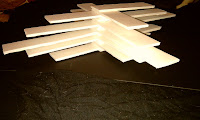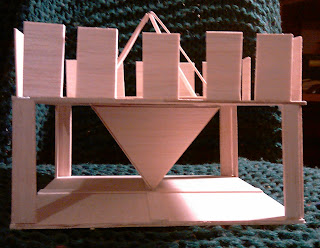
Wednesday, September 22, 2010
First Assignments
Almost forgot about these. These two assignments were our first introduction to creating 3-dimensional forms. The first one had us creating a three-dimensional surface on a two-dimensional plane using an x-acto knife and some creative folding. The second one was to create a three-dimensional sculpture exhibiting gradation and movement. These aren't that great, but I'm putting them up just for you!


Chair Model
Our final assignment is to design and create a chair using nothing more than cardboard and glue. For this week, we were supposed to create a model of our chair using Bristol board. This is my chair. Cute, huh?
more views...
3-D Composition from Balsa Wood
For this assignment, we were supposed to create a three-dimensional composition out of balsa wood. The design was supposed to demonstrate the concepts of line, plane, and volume, while displaying symmetry, balance, harmony, and proportion. I designed it so that the solid form at the bottom would be balanced by the open space surrounding it, while the open form at the top gets some visual weight from the walls of rectangles. However, the two shapes form an octahedron, so the continuation of line is what brings harmony to the piece.
Interlocking Identical Forms
This assignment called for us to design and create our own three-dimensional forms that would be able to interlock. There are examples of this in real life, such as lego blocks and logs for log cabins. I was inspired by Tetris for this one.
Here are some other configurations
Stellated Platonic Solid with a Void
This time our assignment was to add stellations to a Platonic solid. Stellations are additions to a solid that form a point with the number of sides on the stellation equal to the number of sides on the shape to which it's attached. So, since an octahedron is composed of equilateral triangles, its stellations will have 3 sides. I chose to work with the octahedron again and this is how it turned out -- pretty, eh?
In addition to stellations, we were supposed to create a void in one side. This is simply a "hole" dug out of the solid, as you can see here. I created it by folding a stellation inward instead of out, like the others. Bristol board.
Archimedean Solids
Archimedean solids are formed from 2 or more regular polygons. There are only 13 solid shapes that can be formed this way. This one is called a snub cube -- it's composed of 12 squares and 32 equilateral triangles. Bristol board.
Platonic Solids
No, that's not a solid who's just a friend. :) Named after Plato, who studied geometric solids. He identified 5 shapes that could be formed from multiplying regular polygons (that is, a shape with equal angles and equal-length sides).
Here's a li'l octahedron (that's a solid composed of eight equilateral triangles) I made from Bristol board and love.
Here's a li'l octahedron (that's a solid composed of eight equilateral triangles) I made from Bristol board and love.
And now some 3-D stuff
An assortment of projects from my Theory and Development of Form class this quarter...
It's the FINAL COUNTDOOOOWN!!!
Haha, now you have that song in your head, don't you? This is my final drawing for this class. It's supposed to incorporate everything we've learned this quarter about shadow, light, tonal and line variation, and drawing objects in perspective. In addition, it had to include one horizontal cylinder, one vertical cylinder, at least 2 ellipses, one abstract letter or symbol drawn using a rectangular prism as a guide (that's the pi in the sky you see), and a clear light source. I chose to render a surrealistic scene in 2-point perspective.
graphite and charcoal on paper.
graphite and charcoal on paper.
Three-Point Perspective Drawing
*Sigh* This is my favorite drawing I've done so far and unfortunately the flash washed out the rich, rich color I spent hours lovingly applying. Trust me when I say it's bad-ass. ;)
colored pencil and marker on paper.
colored pencil and marker on paper.
Cone, Cube, and Cast Shadows
This assignment called for us to draw a cone and a rectangular prism in a scene with a defined light source. Thanks to Matt for coming up with the idea for this drawing!
graphite, charcoal, and colored pencil on paper.
graphite, charcoal, and colored pencil on paper.
One-Point Perspective from a Photograph
This assignment was the same as the last one, except we had to find an example of one-point perspective to interpret. I'd gotten much more comfortable with the Art Stix by the time I finished this -- the color was so rich many people thought I'd used pastels.
colored pencil, graphite, charcoal, and marker on paper.
colored pencil, graphite, charcoal, and marker on paper.
Two-Point Perspective from a Photograph
For this drawing, we were to find a photograph depicting two-point perspective and interpret it. This one was very popular with the class.
graphite and charcoal on paper.
graphite and charcoal on paper.
Two-Point Perspective Boxes
Two-point boxes this time. Again, practicing drawing above, below, and straddling the horizon. I had just purchased some fancy Prismacolor art stix and was attempting to get the hang of them.
colored pencil on paper.
colored pencil on paper.
One-Point Perspective Buildings
This is a sketchy drawing of a few buildings in one-point perspective, one below the horizon, one straddling it, and one above it.
graphite and colored pencil on paper.
graphite and colored pencil on paper.
One-Point Perspective Boxes
My first foray into perspective drawing, we were to draw a series of boxes at different heights above, below, and straddling the horizon.
graphite and colored pencil on paper.
graphite and colored pencil on paper.
Perspectives
The next 8 pictures will be of my assignments for Perspective Drawing class this quarter. I had fun in this class, and it pushed me to excel in my drawing even more than before. I hope you enjoy my work...
Subscribe to:
Comments (Atom)























